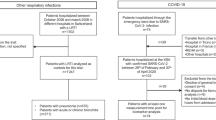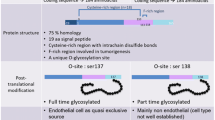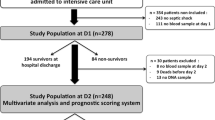Abstract
Purpose
Excessive activation of the endothelium is associated with adverse outcomes in patients with systemic infections. Endothelium-associated peptides, such as endothelin-1 (ET-1), correlate closely with endothelial activation, and therefore serve as surrogate biomarkers. Our aim was to investigate precursor peptides of endothelin-1 (proET1) on admission and during follow-up on days 3, 5 and 7 in a prospective cohort of 925 patients with community-acquired pneumonia.
Methods
We investigated the association of initial and follow-up proET1 and other prohormone levels with 30-day mortality and ICU admission in proportional Cox regression models with time-varying covariates adjusted for the pneumonia-severity-index (PSI), and calculated reclassification statistics.
Results
The mortality rate and ICU admission rate were 5.4% (95% CI 3.9–6.8%) and 9.0% (95% CI 7.1–10.8%). ProET1 levels on admission and changes from baseline to day 3 were significant mortality predictors with adjusted hazard ratios of 10.5 (95% CI 2.9–38.6) and 28.4 (95% CI 7.0–115.1). Initial proET1 levels improved the PSI in reclassification statistics (net reclassification improvement of 0.29, p < 0.0001) and in c-statistics (from 0.79 to 0.83, p < 0.01). Changes of proET1 on day 3 improved the c-statistic of the combined model of PSI and initial proET1 from 0.80 to 0.85 (p < 0.01) and reclassification tables demonstrated a significant improvement (net reclassification improvement 0.44, p < 0.0001). Similar significant results were found for the risk for ICU admission.
Conclusions
In community-acquired pneumonia, ET-1 precursor peptides on admission and changes from baseline to day 3 were independent predictors for mortality and ICU admission, and significantly improved the PSI. If verified in intervention studies, monitoring of proET1 may be helpful for endothelium targeting therapies and for risk stratification complementary to other prohormones.

Similar content being viewed by others
Abbreviations
- ADH:
-
Antidiuretic hormone
- ADM:
-
Adrenomedullin
- ANP:
-
Atrial-natriuretic peptide
- ATS:
-
American Thoracic Society
- AUC:
-
Area under the receiver operating characteristic curve
- CAP:
-
Community-acquired pneumonia
- CI:
-
Confidence interval
- ET1:
-
Endothelin1
- HR:
-
Hazard ratio
- ICU:
-
Intensive care unit
- IDI:
-
Integrated discrimination improvement
- IQR:
-
Interquartile ranges
- NRI:
-
Net reclassification improvement
- PSI:
-
Pneumonia Severity Index
- PCT:
-
Procalcitonin
- ROC:
-
Receiver operating characteristic curve
- TRACE:
-
Time-resolved amplified cryptate emission
References
Lee WL, Slutsky AS (2010) Sepsis and endothelial permeability. N Engl J Med 363:689–691
Aird WC (2003) The role of the endothelium in severe sepsis and multiple organ dysfunction syndrome. Blood 101:3765–3777
Shah R (2007) Endothelins in health and disease. Eur J Int Med 18:272–282
Wanecek M, Weitzberg E, Rudehill A, Oldner A (2000) The endothelin system in septic and endotoxin shock. Eur J Pharmacol 407:1–15
Aird WC (2008) Endothelium in health and disease. Pharmacol Rep 60:139–143
Hemsen A, Modin A, Weitzberg E (1996) Increased concentrations of endothelin-1 messenger RNA in tissues and endothelin-1 peptide in plasma in septic pigs: modulation by betamethasone. Crit Care Med 24:1530–1536
Brauner JS, Rohde LE, Clausell N (2000) Circulating endothelin-1 and tumor necrosis factor-alpha: early predictors of mortality in patients with septic shock. Intensive Care Med 26:305–313
Tschaikowsky K, Sagner S, Lehnert N, Kaul M, Ritter J (2000) Endothelin in septic patients: effects on cardiovascular and renal function and its relationship to proinflammatory cytokines. Crit Care Med 28:1854–1860
Wanecek M, Oldner A, Sundin P, Alving K, Weitzberg E, Rudehill A (1999) Effects on haemodynamics by selective endothelin ET(B) receptor and combined endothelin ET(A)/ET(B) receptor antagonism during endotoxin shock. Eur J Pharmacol 386:235–245
Krejci V, Hiltebrand LB, Erni D, Sigurdsson GH (2003) Endothelin receptor antagonist bosentan improves microcirculatory blood flow in splanchnic organs in septic shock. Crit Care Med 31:203–210
Oldner A, Wanecek M, Goiny M, Weitzberg E, Rudehill A, Alving K, Sollevi A (1998) The endothelin receptor antagonist bosentan restores gut oxygen delivery and reverses intestinal mucosal acidosis in porcine endotoxin shock. Gut 42:696–702
Iskit AB, Senel I, Sokmensuer C, Guc MO (2004) Endothelin receptor antagonist bosentan improves survival in a murine caecal ligation and puncture model of septic shock. Eur J Pharmacol 506:83–88
Wanecek M, Weitzberg E, Alving K, Rudehill A, Oldner A (2001) Effects of the endothelin receptor antagonist bosentan on cardiac performance during porcine endotoxin shock. Acta Anaesthesiol Scand 45:1262–1270
Weitzberg E, Hemsen A, Rudehill A, Modin A, Wanecek M, Lundberg JM (1996) Bosentan-improved cardiopulmonary vascular performance and increased plasma levels of endothelin-1 in porcine endotoxin shock. Br J Pharmacol 118:617–626
Struck J, Morgenthaler NG, Bergmann A (2005) Proteolytic processing pattern of the endothelin-1 precursor in vivo. Peptides 26:2482–2486
Papassotiriou J, Morgenthaler NG, Struck J, Alonso C, Bergmann A (2006) Immunoluminometric assay for measurement of the C-terminal endothelin-1 precursor fragment in human plasma. Clin Chem 52:1144–1151
Schuetz P, Christ-Crain M, Morgenthaler N, Struck J, Bergmann A, Müller B (2007) Circulating precursor levels of endothelin-1 and adrenomedullin, two endothelium-derived, counteracting substances, in sepsis. Endothelium 14:345–351
Schuetz P, Stolz D, Mueller B, Morgenthaler NG, Struck J, Mueller C, Bingisser R, Tamm M, Christ-Crain M (2008) Endothelin-1 precursor peptides correlate with severity of disease and outcome in patients with community acquired pneumonia. BMC Infect Dis 8:22
Kruger S, Ewig S, Giersdorf S, Hartmann O, Suttorp N, Welte T (2010) Cardiovascular and inflammatory biomarkers to predict short- and long-term survival in community-acquired pneumonia. Am J Respir Crit Care Med 182:1426–1434
Samransamruajkit R, Moonviriyakit K, Vanapongtipagorn P, Prapphal N, Deerojanawong J, Poovorawan Y (2002) Plasma endothelin-1 in infants and young children with acute bronchiolitis and viral pneumonia. Asian Pac J Allergy Immunol 20:229–234
Ando T, Ogawa K, Yamaki K, Hara M, Takagi K (1996) Plasma concentrations of atrial, brain, and C-type natriuretic peptides and endothelin-1 in patients with chronic respiratory diseases. Chest 110:462–468
Schuetz P, Christ-Crain M, Thomann R, Falconnier C, Wolbers M, Widmer I, Neidert S, Fricker T, Blum C, Schild U, Regez K, Schoenenberger R, Henzen C, Bregenzer T, Hoess C, Krause M, Bucher HC, Zimmerli W, Mueller B (2009) Effect of procalcitonin-based guidelines vs. standard guidelines on antibiotic use in lower respiratory tract infections: the ProHOSP randomized controlled trial. JAMA 302:1059–1066
Schuetz P, Wolbers M, Christ-Crain M, Thomann R, Falconnier C, Widmer I, Neidert S, Fricker T, Blum C, Schild U, Morgenthaler NG, Schoenenberger R, Henzen C, Bregenzer T, Hoess C, Krause M, Bucher HC, Zimmerli W, Mueller B (2010) Prohormones for prediction of adverse medical outcome in community-acquired pneumonia and lower respiratory tract infections. Crit Care (London, England) 14:R106
Vazquez M, Jockers K, Christ-Crain M, Zimmerli W, Muller B, Schuetz P (2010) MR-pro-atrial natriuretic peptide (MR-proANP) predicts short- and long-term outcomes in respiratory tract infections: a prospective validation study. Int J Cardiol [Epub ahead of print]
Schuetz P, Widmer I, Chaudri A, Christ-Crain M, Zimmerli W, Mueller B (2010) Prognostic value of procalcitonin in community-acquired pneumonia. Eur Respir J 37:384–392
Schuetz P, Christ-Crain M, Wolbers M, Schild U, Thomann R, Falconnier C, Widmer I, Neidert S, Blum CA, Schonenberger R, Henzen C, Bregenzer T, Hoess C, Krause M, Bucher HC, Zimmerli W, Muller B (2007) Procalcitonin guided antibiotic therapy and hospitalization in patients with lower respiratory tract infections: a prospective, multicenter, randomized controlled trial. BMC Health Serv Res 7:102
Mandell LA, Wunderink RG, Anzueto A, Bartlett JG, Campbell GD, Dean NC, Dowell SF, File TM Jr, Musher DM, Niederman MS, Torres A, Whitney CG (2007) Infectious Diseases Society of America/American Thoracic Society consensus guidelines on the management of community-acquired pneumonia in adults. Clin Infect Dis 44(Suppl 2):S27–S72
Niederman MS, Mandell LA, Anzueto A, Bass JB, Broughton WA, Campbell GD, Dean N, File T, Fine MJ, Gross PA, Martinez F, Marrie TJ, Plouffe JF, Ramirez J, Sarosi GA, Torres A, Wilson R, Yu VL (2001) Guidelines for the management of adults with community-acquired pneumonia. Diagnosis, assessment of severity, antimicrobial therapy, and prevention. Am J Respir Crit Care Med 163:1730–1754
Fine MJ, Auble TE, Yealy DM, Hanusa BH, Weissfeld LA, Singer DE, Coley CM, Marrie TJ, Kapoor WN (1997) A prediction rule to identify low-risk patients with community-acquired pneumonia. N Engl J Med 336:243–250
Struck J, Morgenthaler NG, Bergmann A (2005) Copeptin, a stable peptide derived from the vasopressin precursor, is elevated in serum of sepsis patients. Peptides 26:2500–2504
Morgenthaler NG, Struck J, Alonso C, Bergmann A (2005) Measurement of midregional proadrenomedullin in plasma with an immunoluminometric assay. Clin Chem 51:1823–1829
Struck J, Tao C, Morgenthaler NG, Bergmann A (2004) Identification of an adrenomedullin precursor fragment in plasma of sepsis patients. Peptides 25:1369–1372
Morgenthaler NG, Struck J, Thomas B, Bergmann A (2004) Immunoluminometric assay for the midregion of pro-atrial natriuretic peptide in human plasma. Clin Chem 50:234–236
Cook NR (2008) Statistical evaluation of prognostic versus diagnostic models: beyond the ROC curve. Clin Chem 54:17–23
Grambsch PM, Therneau TM, Fleming TR (1995) Diagnostic plots to reveal functional form for covariates in multiplicative intensity models. Biometrics 51:1469–1482
Pencina MJ, D’Agostino RB Sr, D’Agostino RB Jr, Vasan RS (2008) Evaluating the added predictive ability of a new marker: from area under the ROC curve to reclassification and beyond. Stat Med 27:157–172 discussion 207–112
Grandel U, Grimminger F (2003) Endothelial responses to bacterial toxins in sepsis. Crit Rev Immunol 23:267–299
Kedzierski RM, Yanagisawa M (2001) Endothelin system: the double-edged sword in health and disease. Annu Rev Pharmacol Toxicol 41:851–876
Sanai L, Haynes WG, MacKenzie A, Grant IS, Webb DJ (1996) Endothelin production in sepsis and the adult respiratory distress syndrome. Intensive Care Med 22:52–56
Voerman HJ, Stehouwer CD, van Kamp GJ, Strack van Schijndel RJ, Groeneveld AB, Thijs LG (1992) Plasma endothelin levels are increased during septic shock. Crit Care Med 20:1097–1101
File TM Jr, Marrie TJ (2010) Burden of community-acquired pneumonia in North American adults. Postgrad Med 122:130–141
Fine MJ, Hough LJ, Medsger AR, Li YH, Ricci EM, Singer DE, Marrie TJ, Coley CM, Walsh MB, Karpf M, Lahive KC, Kapoor WN (1997) The hospital admission decision for patients with community-acquired pneumonia. Results from the pneumonia Patient Outcomes Research Team cohort study. Arch Intern Med 157:36–44
Schuetz P, Koller M, Christ-Crain M, Steyerberg E, Stolz D, Muller C, Bucher HC, Bingisser R, Tamm M, Muller B (2008) Predicting mortality with pneumonia severity scores: importance of model recalibration to local settings. Epidemiol Infect 136:1628–1637
Schuetz P, Christ-Crain M, Muller B (2009) Procalcitonin and other biomarkers to improve assessment and antibiotic stewardship in infections—hope for hype? Swiss Med Wkly 139:318–326
Albertini M, Clement MG, Hussain SN (2003) Role of endothelin ETA receptors in sepsis-induced mortality, vascular leakage, and tissue injury in rats. Eur J Pharmacol 474:129–135
Antonelli M, Azoulay E, Bonten M, Chastre J, Citerio G, Conti G, De Backer D, Lemaire F, Gerlach H, Hedenstierna G, Joannidis M, Macrae D, Mancebo J, Maggiore SM, Mebazaa A, Preiser JC, Pugin J, Wernerman J, Zhang H (2010) Year in review in Intensive Care Medicine 2009: I. Pneumonia and infections, sepsis, outcome, acute renal failure and acid base, nutrition and glycaemic control. Intensive Care Med 36:196–209
Andrews P, Azoulay E, Antonelli M, Brochard L, Brun-Buisson C, De Backer D, Dobb G, Fagon JY, Gerlach H, Groeneveld J, Macrae D, Mancebo J, Metnitz P, Nava S, Pugin J, Pinsky M, Radermacher P, Richard C (2007) Year in review in Intensive Care Medicine, 2006. II. Infections and sepsis, haemodynamics, elderly, invasive and noninvasive mechanical ventilation, weaning, ARDS. Intensive Care Med 33:214–229
Sligl WI, Majumdar SR, Marrie TJ (2009) Triaging severe pneumonia: what is the “score” on prediction rules? Crit Care Med 37:3166–3168
Leone M, Boutiere B, Camoin-Jau L, Albanese J, Horschowsky N, Mege JL, Martin C, Dignat-George F (2002) Systemic endothelial activation is greater in septic than in traumatic-hemorrhagic shock but does not correlate with endothelial activation in skin biopsies. Crit Care Med 30:808–814
Acknowledgments
We thank Prof. E.Orav for very helpful scientific discussions. We are grateful to the Data Safety and Monitoring Board, namely A. P. Perruchoud, S. Harbarth and A. Azzola for continuous supervision of this trial and all local physicians, the nursing staff, the patients and their relatives who participated in this study. Especially, we thank the staff of the emergency room, medical clinics and central laboratories of the University Hospital Basel, the Cantonal Hospitals Liestal, Aarau, Luzern and Muensterlingen and the “Buergerspital” Solothurn for their very helpful assistance, patience and technical support. We thank other members of the ProHOSP Study Group for their important help during the study. The initial trial was supported by grant SNF 3200BO-116177/1 from the Swiss National Science Foundation. Dr. Schuetz was supported by a research grant from the Swiss Foundation for Grants in Biology and Medicine (Schweizerische Stiftung für medizinisch-biologische Stipendien, SSMBS, PASMP3-127684/1). Dr. Christ-Crain was supported by a grant of the Swiss National Science Foundation (PP00P3-12346).
Conflict of interest
No commercial sponsor had any involvement in design and conduct of this study, namely collection, management, analysis, and interpretation of the data; and preparation, decision to submit, review, or approval of the manuscript. PS, MCC and BM received support from BRAHMS to attend meetings and fulfilled speaking engagements. BM has served as a consultant and received research support. All other authors declare that they have no competing interests.
Author information
Authors and Affiliations
Corresponding author
Additional information
Members of the ProHOSP Study Group are listed in the appendix.
Electronic supplementary material
Below is the link to the electronic supplementary material.
Appendix
Appendix
The ProHOSP Study group included the following persons: Ursula Schild, RN, Katharina Regez, RN, Rita Bossart, RN, Robert Thomann, MD, Claudine Falconnier, MD, Marcel Wolbers, PHD, Stefanie Neidert, MD, Thomas Fricker, MD, Claudine Blum, MD, Ronald Schoenenberger, MD, Christoph Henzen, MD, Thomas Bregenzer, MD, Claus Hoess, MD, Martin Krause, MD, Heiner C. Bucher, MD, Fabian Mueller, Jeannine Haeuptle, Roya Zarbosky, Rico Fiumefreddo, Melanie Wieland, RN, Charly Nusbaumer, MD, Andres Christ, MD, Roland Bingisser, MD, Kristian Schneider, RN, Brigitte Walz, PhD, Verena Briner, MD, Dieter Conen, MD, Andreas Huber, MD, Jody Staehelin, MD, Aarau, Chantal Bruehlhardt, RN, Ruth Luginbuehl, RN, Agnes Muehlemann, PhD, Ineke Lambinon and Max Zueger, MD.
Rights and permissions
About this article
Cite this article
Schuetz, P., Christ-Crain, M., Zimmerli, W. et al. Repeated measurements of endothelin-1 precursor peptides predict the outcome in community-acquired pneumonia. Intensive Care Med 37, 970–980 (2011). https://doi.org/10.1007/s00134-011-2208-2
Received:
Accepted:
Published:
Issue Date:
DOI: https://doi.org/10.1007/s00134-011-2208-2




